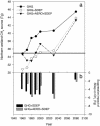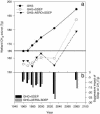Sulfur pollution suppression of the wetland methane source in the 20th and 21st centuries
- PMID: 15297612
- PMCID: PMC515100
- DOI: 10.1073/pnas.0404412101
Sulfur pollution suppression of the wetland methane source in the 20th and 21st centuries
Abstract
Natural wetlands form the largest source of methane (CH(4)) to the atmosphere. Emission of this powerful greenhouse gas from wetlands is known to depend on climate, with increasing temperature and rainfall both expected to increase methane emissions. This study, combining our field and controlled environment manipulation studies in Europe and North America, reveals an additional control: an emergent pattern of increasing suppression of methane (CH(4)) emission from peatlands with increasing sulfate (SO(4)(2-)-S) deposition, within the range of global acid deposition. We apply a model of this relationship to demonstrate the potential effect of changes in global sulfate deposition from 1960 to 2080 on both northern peatland and global wetland CH(4) emissions. We estimate that sulfur pollution may currently counteract climate-induced growth in the wetland source, reducing CH(4) emissions by approximately 15 Tg or 8% smaller than it would be in the absence of global acid deposition. Our findings suggest that by 2030 sulfur pollution may be sufficient to reduce CH(4) emissions by 26 Tg or 15% of the total wetland source, a proportion as large as other components of the CH(4) budget that have until now received far greater attention. We conclude that documented increases in atmospheric CH(4) concentration since the late 19th century are likely due to factors other than the global warming of wetlands.
Figures



Comment in
-
Playing scales in the methane cycle: from microbial ecology to the globe.Proc Natl Acad Sci U S A. 2004 Aug 24;101(34):12400-1. doi: 10.1073/pnas.0405075101. Epub 2004 Aug 16. Proc Natl Acad Sci U S A. 2004. PMID: 15314221 Free PMC article. No abstract available.
References
-
- Lelieveld, J., Crutzen, P. & Dentener, F. J. (1998) Tellus 5B, 128–150.
-
- Intergovernmental Panel on Climate Change (IPCC) (2001) Climate Change 2001: The Scientific Basis—Contribution of Working Group I to the Third Assessment Report of IPCC (Cambridge Univ. Press, Cambridge, U.K.).
-
- Matthews, E. (2000) in Atmospheric Methane: Its Role in the Global Environment, ed. Kahlil, M. A. K. (Springer, New York), pp. 202–233.
-
- Dise, N. B., Gorham, E., Verry, E. S. (1993) J. Geophys. Res. Atmos. 98, 10583–10594.
-
- Freeman, C., Lock, M, A. & Reynolds, B. (1993) Biogeochemistry 19, 51–60.
Publication types
MeSH terms
Substances
LinkOut - more resources
Full Text Sources
Other Literature Sources
Miscellaneous

